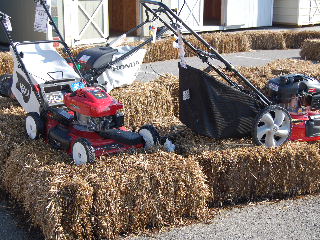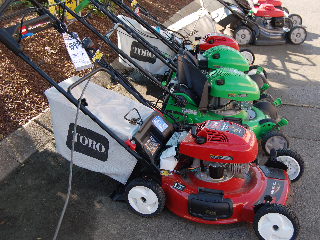
As we think about ways to be good stewards of the environment while we go about our daily lives at work, at home, at leisure, and while we are in direct contact with the great outdoors itself, one of the first things that comes to mind is the use of grass bagging attachments on lawnmowers.
It’s for certain that planting, nurturing, and maintaining a thriving and healthy lawn makes us part of a hands-on active experiment in environmental awareness.
After all, healthy actively growing grass promotes the all-important carbon dioxide/oxygen exchange so necessary to our existence on this planet.
As we conduct the seemingly mundane and simple task of mowing the lawn, what can we do to make this an important and real example of living and working wisely in the world we are trying to protect? How about the use of (or more importantly, the non-use of) your bagging attachment?
Unless you are trying to collect more organic matter to add to your compost pile (see my article entitled
A Toast to Compost), I don’t recommend using these devices. Otherwise, what will you do with the collected vegetation other than filling up trash bags and setting them out at the curb for garbage collection?
We certainly don’t need more organic matter being added to our already over-flowing landfills, and in fact many municipalities will no longer pick up organic matter as trash.

The best thing to do is to allow the well-chopped clippings to remain on the lawn since their decomposition adds valuable nitrogen back to your soil.
The same is true of well-mulched dried leaves as they fall from your trees. The only caution is to not allow the grass clippings or mulched leaves to accumulate too thickly on the lawn; just continue to mow over them until they are thoroughly chopped.
The best way to avoid too heavy an abundance of clippings, of course, is to mow frequently enough that your lawnmower is not removing more than ½ to 1 inch of vegetation per cutting. This may mean mowing a little more often in the fast growth time of spring and less often as the grass slows its growth rate during the hotter drier summer months.
Some lawnmowers have a mulching attachment, which is simply a plate or covering over the opening where the clippings would normally be expelled from under the mowing deck. When used on a mower that is equipped with a mulching blade, this plate allows the clippings to be re-circulated and chopped to a finer consistency under the deck.
Even in the absence of a mulching plate or mulching blade, an ordinary lawnmower should still leave clippings that are fine enough to remain on the growing lawn if, as we have said, the grass is not allowed to grow too tall between mowings.
So, if a bagging attachment comes with your new lawnmower, take it. Just remember to use it with discretion.
 As we think about ways to be good stewards of the environment while we go about our daily lives at work, at home, at leisure, and while we are in direct contact with the great outdoors itself, one of the first things that comes to mind is the use of grass bagging attachments on lawnmowers.
As we think about ways to be good stewards of the environment while we go about our daily lives at work, at home, at leisure, and while we are in direct contact with the great outdoors itself, one of the first things that comes to mind is the use of grass bagging attachments on lawnmowers.
 The best thing to do is to allow the well-chopped clippings to remain on the lawn since their decomposition adds valuable nitrogen back to your soil.
The best thing to do is to allow the well-chopped clippings to remain on the lawn since their decomposition adds valuable nitrogen back to your soil.